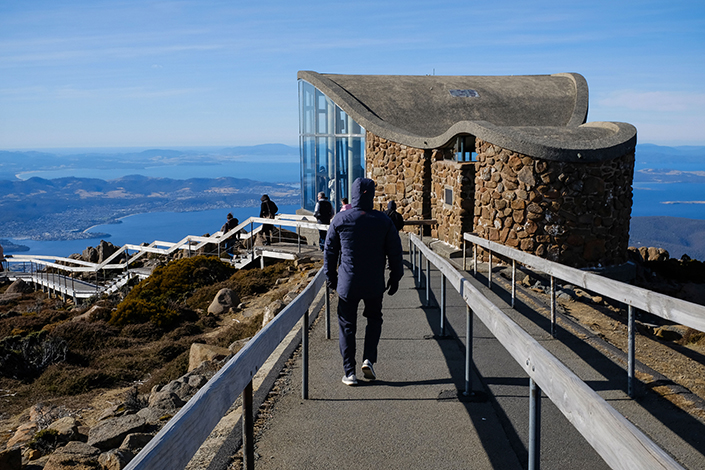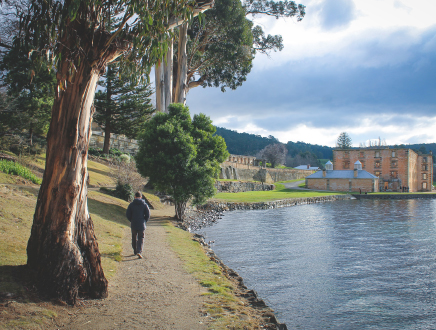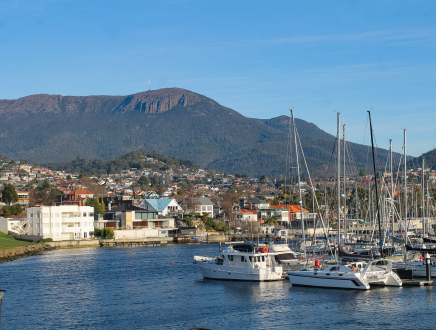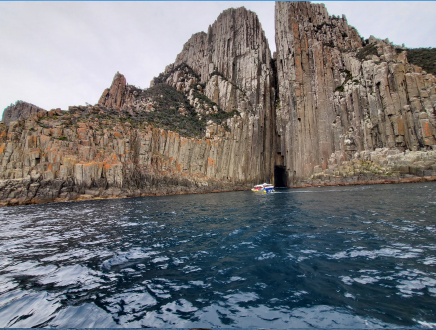Adventures in Southern Australia
By Rachel Coffman

For many years, my travel bucket list excluded Australia. It seemed to lack the historic, aesthetic appeal that drew me to Europe or the vibrant, eclectic culture of South America I had enjoyed on my travels. Australia was a destination I didn’t feel the need to rush to visit, and when considering a trip there, Tasmania wasn’t top of mind. However, my assumptions could not have been more wrong. Tasmania should be on everyone’s bucket list.
How does one choose Tasmania if it’s not already on their radar? As often happens with unexpected destinations, my significant other, Jeb, was invited to present at the Australian
International Taxi Conference in Hobart, Tasmania, in August 2023.
Stepping off the plane, I immediately knew Tasmania was special. The crisp air felt medicinal as it carried the coolness and virginity of place from the winds drifting off Antarctica. I felt both nervous and overwhelmed as this was my first international trip since 2020.
 Arriving in Hobart, the capital city of Tasmania, on a Saturday meant we would drop our bags and head straight to Salamanca Place for the weekly market held every Saturday. We were greeted with hints of spring peeking through the edges of winter. The Salamanca Market is a showcase of Tasmanian culture and a reflection of its commitment to quality. Vendor after vendor displayed agricultural products and meticulously crafted art.
Arriving in Hobart, the capital city of Tasmania, on a Saturday meant we would drop our bags and head straight to Salamanca Place for the weekly market held every Saturday. We were greeted with hints of spring peeking through the edges of winter. The Salamanca Market is a showcase of Tasmanian culture and a reflection of its commitment to quality. Vendor after vendor displayed agricultural products and meticulously crafted art.
The central feature of Hobart is Mount Wellington, which ascends 4,170 feet above the city. Wedged between the mountain and the Derwent River, Hobart felt more Nordic than Australian. Adjacent to Salamanca and the city center is Battery Point, one of the oldest neighborhoods in the city, where you will find sandstone cottages holding the history of its maritime past. Many of our mornings in Hobart began in this neighborhood, walking to what became our favorite breakfast spot, Jackman & McRoss. This bakery-turned-must-eat stop for any traveler offers a large selection of pastries, breakfast items and local pies. A must-try is the scallop pie with its distinct curry flavor.
As I mentioned, the scallop pie is a local déclassé and alone might be worth the flight. The timing of our trip had allowed us to enjoy the Tasmanian Whiskey Week festival. We found ourselves as the only non-locals for the tasting dinner where we were able to meet Bill Lark, the founder of Lark Distillery, and the Tasmanian Whiskey industry that is now delivering quality whiskey to rival those coming from Scotland.
When we met Lark, he asked what my favorite was in the dinner, and I answered Lark Classic Cask. He replied slyly, “Mine too.”
I was unaware of who I was speaking to and quite embarrassed when he disclosed his connection to the industry. It was an honor to spend the time talking to Lark, who has revolutionized the distilling industry on the island. Whiskey tasting at Tasmanian’s distilleries is a perfect afternoon in Hobart. Lark Distillery and Overeem are excellent choices.
Craftsmanship in Tasmania extends from whiskey and wine to cheese making and chocolate. A must-do day trip is Bruny Island, located south of the city and accessible by ferry. Bruny Island has deep Indigenous roots, and Tasmanian Aboriginal culture is still prevalent on the island today, showcasing the Nuenonne culture. Its shores greeted many early explorers like Tasmania’s namesake, Abel Tasman. We took a tour with Pennicott Wilderness Journeys and highly recommend both their Bruny Island and Tasman Peninsula day tours.
On our Bruny Island tour, our first stop was a local oyster shop for lunch, followed by a tasting and tour at Bruny Island Cheese Co. Unlike those aiming to replicate French or German cheeses, Bruny Island Cheese Co. creates distinct Tasmanian cheeses, known to be some of the finest in the country. Founded by Nick Haddow in 2003, the company is celebrated for its commitment to traditional cheese-making techniques and the use of high-quality local ingredients. The cheese is made with milk from cows and goats that graze on the island’s lush pastures, resulting in rich and flavorful products.
The tour featured several artisanal food producers, including those making chocolate and honey. The fauna of Bruny Island is remarkably diverse. The northern part of the island has a dry climate, while the southern part, separated by a narrow land strip called The Neck, hosts a temperate rainforest. If you’re lucky, a Bruny Island tour can include spotting the rare white wallaby, only found on the island. These white wallabies are a result of a genetic mutation that causes leucism, a condition where there is a partial loss of pigmentation. This rare trait is preserved on Bruny Island due to the isolation and limited number of predators, allowing these unique creatures to thrive.
Tasmania’s harsh landscape made it an ideal location for England’s penal settlements when Australia was established as a penal colony. The rugged and remote terrain of the Tasman Peninsula was perfect for isolating convicts. The dense forests, rocky coastlines and rough seas acted as natural barriers, making escape nearly impossible.
The most infamous of these settlements was Port Arthur, established in 1830. It was strategically located on the Tasman Peninsula, accessible only by a narrow land bridge called Eaglehawk Neck. This isthmus was heavily guarded by soldiers and ferocious dogs, further ensuring the security of the prison. Port Arthur became a model of the separate system, where prisoners were kept in isolation to prevent communication and plotting escapes.
The harsh conditions of the landscape not only provided security but also served as a constant reminder of the prisoners’ punishment. The natural features of the peninsula, such as the towering sea cliffs and dense bushland, added to the psychological and physical challenges faced by the convicts.
 We did a combined day tour with Pennicott’s Wilderness Journeys to explore the Tasman Peninsula by boat and visit the Port Arthur Historic Site. I was surprised by how much I enjoyed Port Arthur. Upon entry, you are handed a playing card that matches one on the wall. When you find your match, you learn about the history of a former prisoner or staff member at the site. For Jeb, a man who found his way into Australia as a speaker at the Australian International Taxi Conference representing the Transportation Alliance, it was only fitting that his card read Robert Ashford, serving a life sentence at Port Arthur working in transportation.
We did a combined day tour with Pennicott’s Wilderness Journeys to explore the Tasman Peninsula by boat and visit the Port Arthur Historic Site. I was surprised by how much I enjoyed Port Arthur. Upon entry, you are handed a playing card that matches one on the wall. When you find your match, you learn about the history of a former prisoner or staff member at the site. For Jeb, a man who found his way into Australia as a speaker at the Australian International Taxi Conference representing the Transportation Alliance, it was only fitting that his card read Robert Ashford, serving a life sentence at Port Arthur working in transportation.
We walked around Port Arthur for about two hours, examining the small scale of the cells. We walked in the footsteps of those who served here, often for crimes born of hunger, like stealing bread or other petty offenses. The orange-tinted walls of the former penitentiary stood in stark contrast to the beautiful tall eucalyptus trees in the background. It was hard to imagine the pain and torment conducted in what is such a beautiful place.
Tasmania’s beauty is probably no more apparent than along the coast. With nothing in between you and Antarctica, the Tasman Peninsula meets the harsh robust winds coming from the world below. The peninsula is home to the tallest sea cliffs in the Southern Hemisphere, the most notable being Cape Pillar and Cape Raoul. These cliffs are the result of ancient volcanic activity, where molten rock cooled and solidified into vertical columns of dolerite. Over millions of years, the relentless forces of wind and waves have sculpted these cliffs into their current dramatic forms.
The artist in me was intrigued by how nature colored the rocks a bright orange from algae, creating a striking contrast with the deep cerulean color of the sea. The orange and blue hues, which are complementary on the color wheel, created a visually captivating scene. On these rocks were various forms of marine life from seals to birds. We were fortunate enough to see a group of albatrosses resting off the coast. Albatrosses can go years without touching the ground, and we were allowed to witness the rarity of their moment of pause.
From sea level to the apex of Mount Wellington, the Tasman coast must be seen from all vantage points. On a clear day, at the top of Mount Wellington, you can see out to Bruny Island and the Tasman Peninsula. No trip to Hobart is complete without the drive to the summit. If you don’t have a car, it might be quicker and cheaper to take a taxi. Our friends at 13 Cabs are highly recommended. On the descent, a must-stop is Australia’s oldest continuously operational brewery, Cascade. Cascade is not a tourist trap—the beer and the cheese plate are both amazing. We spent lunch enjoying the gardens around the brewery.
I have mentioned whiskey and beer, but don’t worry, this story includes wine too. There are many day tours from Hobart to the Coal River Valley and Richmond winery areas. My favorite was Craigow Vineyard, a small boutique winery established in the late 1980s by Dr. Michael Dunbabin. Craigow Vineyard has developed a reputation for producing high-quality wines that reflect the unique terroir of the area. Upon entering Craigow, you feel like you are stepping into someone’s home. Dunbabin capitalizes on this feeling, making you feel welcome and personally directing the tasting.
His passion for his products is evident, and of the five vineyards we visited that day, his wines surpassed the rest. The most unique tasting was the sparkling Merlot. When chilled, the entire complexity of flavor is changed. I safely transported a bottle home and shared it with family over Christmas Eve.
With any new place, there is a moment of reflection. My moment of realization that I was in Australia came while sitting in a beanbag chair enjoying a jazz benefit at the Museum of Old and New Art (MONA). MONA is the most unique museum I have ever visited. It wasn’t just the collection of art but the building itself that was a piece of art. MONA, the largest privately funded museum in Australia, was built by David Walsh, a Tasmanian businessman and art collector.
Walsh, who made his fortune through a gambling system he developed, opened MONA in 2011. The museum has quickly become a cultural landmark. The architecture of MONA is striking, with much of it built underground into a sandstone cliff, giving it a labyrinthine feel. The exhibits are provocative and eclectic, ranging from ancient artifacts to contemporary works, designed to challenge and engage visitors in a deeply personal experience.
MONA embodies the spirit of freedom of expression that represents Hobart and Tasmania in general. With its deep convict history, Tasmania has cultivated a rebellious attitude that has translated into eclectic entrepreneurial and artistic endeavors. MONA is not just a museum but a reflection of Tasmania’s rich history and vibrant present, blending the old with the new in a way that is both thought-provoking and inspiring.
Before this trip, my only association with Tasmania was the Tasmanian Devil from “Looney Tunes.” I can now say that I did not see a single Tasmanian Devil in the wild. The cartoon character’s abrasive nature stands in stark contrast to the real Tasmania. This trip taught me that sometimes it’s better to have no expectations and let the journey reveal the place to you.
Tasmania, you were quite the surprise.









